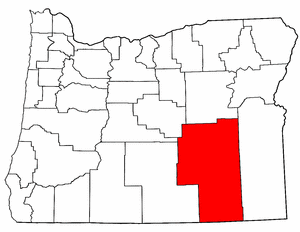Harney County, Oregon
|
|
Harney County is a county created in the state of Oregon in 1889. The county was named for William S. Harney, a military officer of the period, who was involved in the Pig War and popular in the Pacific Northwest. As of 2000, the population is 7,609. The county seat is located at Burns.
| Contents |
Economy
Three industries, ranching, sheep raising, and timber, have traditionally provided the county's economic base. The railroad, which extended into the area in 1883, served as a catalyst to the cattle industry but later contributed to its decline by bringing farmers and sheep men to the area, thus creating increased competition for productive land. Harvesting and breeding of wild horses was lucrative for a period. Harney County shares the largest Ponderosa Pine forest in the nation with Grant County. Its abundance of game, numerous campsites and excellent fishing have stimulated fast-growing recreational activities.
Although county lands were open to homesteading from 1862 to 1934, the U.S. Bureau of Land Management still owns more than three million acres (12,000 km²), or 62% of the lands within the county boundaries. Facilitated on the national level by the Carey Act of 1894, arid land in Harney County was donated to the state for irrigation and settlement, but all water development efforts failed, and eventually all land claims filed under the reclamation legislation were abandoned or nullified. Malheur Wildlife Refuge was established in 1908 and expanded in 1936. The refuge now includes 159,872 acres (647 km²). Borax has been mined in the Steens area, and uranium has been found on its south side.
Geography
Harney is the largest county in Oregon. According to the U.S. Census Bureau, the county has a total area of 26,486 km² (10,226 mi²). 26,248 km² (10,134 mi²) of it is land and 239 km² (92 mi²) of it is water, mostly as part of Lake Harney. The total area is 0.90% water.
Adjacent Counties
- Grant County, Oregon - (north)
- Malheur County, Oregon - (east)
- Lake County, Oregon - (west)
Demographics
As of the census2 of 2000, there are 7,609 people, 3,036 households, and 2,094 families residing in the county. The population density is 0/km² (1/mi²). There are 3,533 housing units at an average density of 0/km² (0/mi²). The racial makeup of the county is 91.93% White, 3.97% Native American, 0.51% Asian, 0.13% Black or African American, 0.07% Pacific Islander, 1.30% from other races, and 2.09% from two or more races. 4.15% of the population are Hispanic or Latino of any race.
There are 3,036 households out of which 29.40% have children under the age of 18 living with them, 58.00% are married couples living together, 6.80% have a female householder with no husband present, and 31.00% are non-families. 25.90% of all households are made up of individuals and 10.20% have someone living alone who is 65 years of age or older. The average household size is 2.45 and the average family size is 2.94.
In the county, the population is spread out with 26.00% under the age of 18, 6.40% from 18 to 24, 26.60% from 25 to 44, 26.10% from 45 to 64, and 15.00% who are 65 years of age or older. The median age is 40 years. For every 100 females there are 102.90 males. For every 100 females age 18 and over, there are 98.20 males.
The median income for a household in the county is $30,957, and the median income for a family is $36,917. Males have a median income of $27,386 versus $21,773 for females. The per capita income for the county is $16,159. 11.80% of the population and 8.60% of families are below the poverty line. Out of the total population, 12.70% of those under the age of 18 and 13.90% of those 65 and older are living below the poverty line.
History
The Native Americans living in this region at the time of the Lewis and Clark Expedition were the Northern Paiute, who fought with the Tenino and Wascos peoples. Peter Skene Ogden was the first European to explore this area when he led a fur brigade for the Hudson's Bay Company in 1826.
Harney County was carved out of the southern two-thirds of Grant County on February 25, 1889. A fierce political battle, with armed night riders who spirited county records from Harney to Burns, ended with Burns as the county seat in 1890. The Malheur River Indian Reservation was created by executive order on March 14, 1871 and the Northern Paiute Indians within the Oregon state boundaries were settled there.
Cities and towns
| State of Oregon | 
| ||
| Regions Columbia River Gorge and Plateau | Eastern Oregon | Inland Empire | Mt. Hood Corridor | Oregon Coast | Western Oregon | Willamette Valley | |||
| Counties | Largest cities (full list) | ||
| Baker | Benton | Clackamas | Clatsop | Columbia | Coos | Crook | Curry | Deschutes | Douglas | Gilliam | Grant | Harney | Hood River | Jackson | Jefferson | Josephine | Klamath | Lake | Lane | Lincoln | Linn | Malheur | Marion | Morrow | Multnomah | Polk | Sherman | Tillamook | Umatilla | Union | Wallowa | Wasco | Washington | Wheeler | Yamhill | Albany | Beaverton | Bend | Corvallis | Eugene | Grants Pass | Gresham | Hillsboro | Keizer | Lake Oswego | McMinnville | Medford | Milwaukie | Oregon City | Portland | Salem | Springfield | Tigard | Tualatin | West Linn | ||

